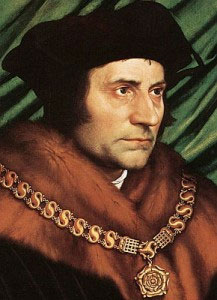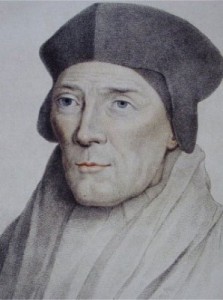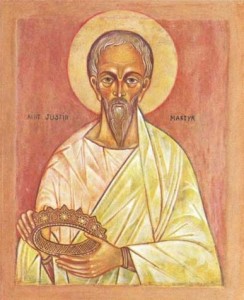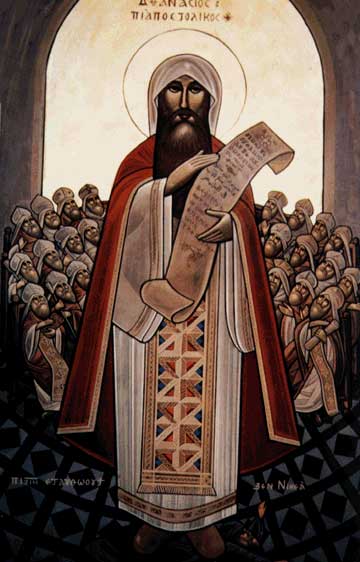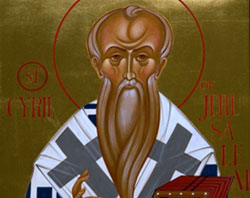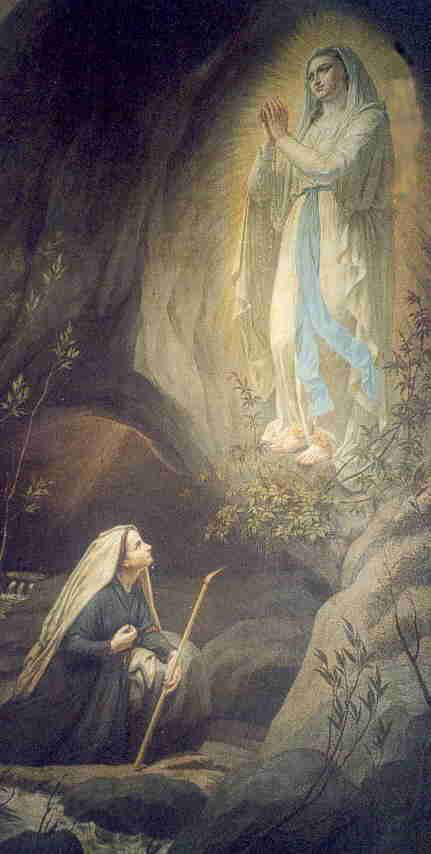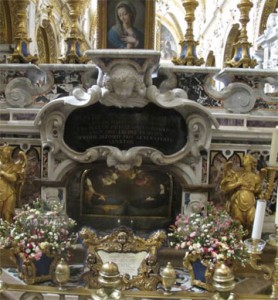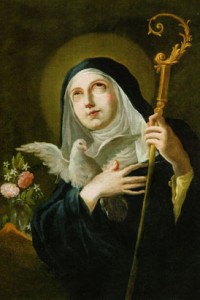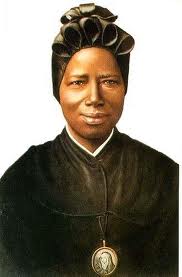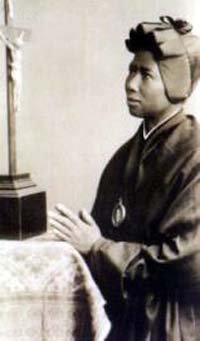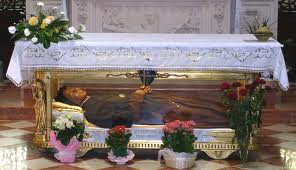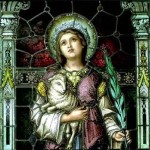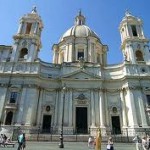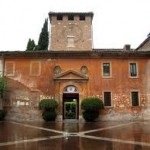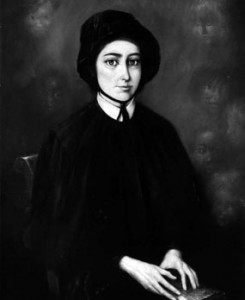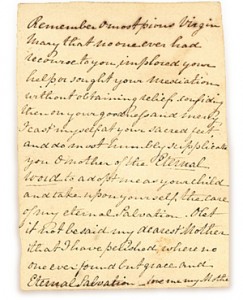I leave it to Omar F. A. Gutierrez to write so well on the life,  times, and death of this great saint.
times, and death of this great saint.
You may perhaps remember a scene from Braveheart with Robert the Bruce and his father the leper.
When his son first brings him news about the rebellion led by William Wallace, a commoner, the father instantly devises a plan by which the Bruce clan can gain favor with the Scots and with the English. You get the feeling that Robert is a bit taken aback by the so easy and cold calculation of his rotted father.
He says,
This Wallace. He doesn’t even have a knighthood. But he fights with passion, and he is clever. He inspires men.
His father replies:
You admire him. Uncompromising men are easy to admire. He has courage. So does a dog. But you must understand this: Edward Longshanks is the most ruthless king ever to sit on the throne of England, and none of us, and nothing of Scotland, will survive unless we are as ruthless, more ruthless, than he.
“Uncompromising men are easy to admire.†There is in this world, and it seems more so today, a habit of admiring the compromising fellow. With the ubiquitous dictatorship of relativism that oppresses so many minds, it only makes sense that the general public would take offense at anyone who dares stand up for something with uncompromising stolidity.
The holder of objective truth claims is – so the sages of Manhattan and Melrose Place tell us – no different than the Nazi who insists on the claim to racial purity or the Islamic bomber who literally does cling to his religion and guns.
For this reason, the figure of St. Thomas More, whose feast it is today, can be such a 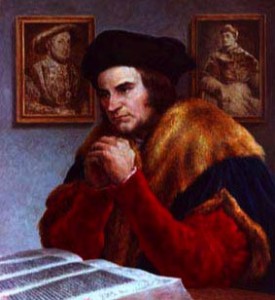 perplexing figure for the modern mind. And even the Catholic who consumes their breakfast whilst pouring over the latest moto proprio can miss this astonishingly great man. I have to admit having skipped over him in my studies, chalking him up with all the other saints and blesseds who gain God’s favor by losing their heads. But St. Thomas More is more than just a martyr.
perplexing figure for the modern mind. And even the Catholic who consumes their breakfast whilst pouring over the latest moto proprio can miss this astonishingly great man. I have to admit having skipped over him in my studies, chalking him up with all the other saints and blesseds who gain God’s favor by losing their heads. But St. Thomas More is more than just a martyr.
He’s an example of such exquisite lack of compromise that he can teach us a great deal about the Catholic Social Doctrine we long to understand and live out. (more…)
Tags: children, england, english reformation, love, martyr, martyrdom, protestant reformation, tudors
This entry was posted on Saturday, June 22nd, 2013 at 6:32 am
You can follow any responses to this entry through the RSS 2.0 feed.
St. John Fisher, 1460-1535
from the Catholic Information Network on St. John Fisher
John Fisher, born at Beverley, Yorkshire, was the son of a prosperous mercer who died in 1477. About 1482 the boy’s mother sent him to Cambridge University where he distinguished himself as a scholar. He was ordained in 1491 on the title of his Fellowship of Michaelhouse (now incorporated in Trinity College). After studying theology for ten years, he took his D.D. in 1501, and was later recognized as one of the leading theologians of Europe.
His university soon discovered his gifts as an administrator; he held in turn the offices of proctor, vice-chancellor and chancellor, and in 1514 he received the unique distinction of being elected chancellor for life. It was in the course of his university duties that, in 1494, he first met the Lady Margaret Beaufort, mother of Henry VII. He became her confessor and advised her on the charitable uses of her great wealth. It was at his suggestion that a preachership was endowed at Cambridge and Readerships in Divinity in both universities. He was largely responsible for her decision to refound and endow Godshouse as Christ’s College, and, after her death in 1509, he carried out her wishes in founding St. John’s College, to which he transferred lands given to him by the Lady Margaret.
He was made bishop of Rochester in 1504, and he ruled that poorest of sees for thirty years; he was a truly pastoral bishop, encouraging his priests by his manner of life and by his interest in their welfare. He was a noted and assiduous preacher, and he did all he could to provide well-instructed priests who could preach to the people.
It was due to his influence that Erasmus was brought to Cambridge as lecturer in Greek. He and Sir Thomas More became close friends of John Fisher, and there is a record of the three being together at Rochester in 1516. Sir Thomas More became High Steward of Cambridge University in 1525. He and John Fisher had been drawn closer together at this period by the call to combat the Lutheran heresy. The bishop wrote his Confutatio (1523) in Latin, a book for theologians by a theologian, which had a wide circulation on
the continent; the layman wrote his Dialogue Concerning Heresies (1528) in English for the common reader. It may be noted that in his sermons and writings against heretics, John Fisher never used the abusive language of contemporary controversy; he relied on reason and persuasion to bring back the prodigals.
The year 1527 was fateful to England, for it was then that Henry VIII took the first steps towards seeking the annulment of his marriage with Catherine of Aragon. She had married his elder brother Arthur in 1501; he died six months later. Catherine always maintained that the marriage had not been consummated. A papal dispensation allowed Henry VIII to marry his brother’s widow in 1509. The lack of a male heir turned his thoughts to the dissolution of his marriage; he argued that the papal dispensation had no validity. Cardinal Wosley was instructed to seek the opinion of John Fisher, whose prestige as a man of holy life and of great learning gave exceptional weight to his views. After studying the problem thoroughly he came to the conclusion that the papal dispensation was valid, and therefore that Henry and Catherine were man and wife in the eyes of the church. From that position he never moved in spite of the pressure brought to bear on him by king and cardinal. He was not content with passive opposition, but in the legatine court set up to try the issue, and from the pulpit, he defended the queen, although he knew that Henry regarded opposition to his will as a form of treason.
An attempt to implicate John Fisher in the fate of the Nun of Kent failed; she had prophesied against the king. A more certain weapon was provided by the Act of Succession of 1534. This declared the king’s marriage to Catherine void, and his subsequent marriage to Anne Boleyn to be lawful; the succession was settled on her children. All had to take an oath accepting the whole Act. When the oath was tendered to
John Fisher he refused to take it; so did Sir Thomas More. Both were prepared to accept the succession as determined by Parliament, but not that part of the Act which implied a denial of the pope’s authority, inasmuch as it declared the papal dispensation invalid.
On April 17th, 1534 Bishop John Fisher and Sir Thomas More were committed to the Tower. They were kept apart.
John Fisher was sixty-five years of age when he was imprisoned; he was suffering from a wasting sickness and was clearly nearing his end. Nothing shows the king’s vindictiveness more than his relentless persecution of this aged man stricken by a fatal illness. On May 20th, 1535, the pope created John Fisher Cardinal-priest of the title of St. Vitalis. This so infuriated the king that he hurried forward the proceedings against the new cardinal. (more…)
Tags: bishop, english reformation, John Fisher, martyr, martyrdom, martyrs of england, priests, protestant reformation
This entry was posted on Saturday, June 22nd, 2013 at 6:00 am
You can follow any responses to this entry through the RSS 2.0 feed.
Join us a we discuss the life St. Justin Martyr with the wonderful Mike Aquilina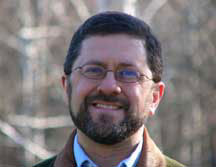
[powerpress]
You can also read the following from Vatican.va
BENEDICT XVI
GENERAL AUDIENCE
St Peter’s Square
Wednesday, 21 March 2007
St Justin, Philosopher and Martyr (c. 100-165)
Dear Brothers and Sisters,
In these Catecheses, we are reflecting on the great figures of the early Church. Today, we will talk about St Justin, Philosopher and Martyr, the most important of the second-century apologist Fathers.
The word “apologist” designates those ancient Christian writers who set out to defend the new religion from the weighty accusations of both pagans and Jews, and to spread the Christian doctrine in terms suited to the culture of their time.
Thus, the apologists had a twofold concern: that most properly called “apologetic”, to defend the newborn Christianity (apologhÃa in Greek means, precisely, “defence”), and the pro-positive, “missionary” concern, to explain the content of the faith in a language and on a wavelength comprehensible to their contemporaries.
Justin was born in about the year 100 near ancient Shechem, Samaria, in the Holy Land; he spent a long time seeking the truth, movi
Finally, as he himself recounts in the first chapters of his Dialogue with Tryphon, a mysterious figure, an old man he met on the seashore, initially leads him into a crisis by showing him that it is impossible for the human being to satisfy his aspiration to the divine solely with his own forces. He then pointed out to him the ancient prophets as the people to turn to in order to find the way to God and “true philosophy”.ng through the various schools of the Greek philosophical tradition.In taking his leave, the old man urged him to pray that the gates of light would be opened to him.
The story foretells the crucial episode in Justin’s life: at the end of a long philosophical journey, a quest for the truth, he arrived at the Christian faith. He founded a school in Rome where, free of charge, he initiated students into the new religion, considered as the true philosophy. Indeed, in it he had found the truth, hence, the art of living virtuously.For this reason he was reported and beheaded in about 165 during the reign of Marcus Aurelius, the philosopher-emperor to whom Justin had actually addressed one of his Apologia.
These - the two Apologies and the Dialogue with the Hebrew, Tryphon - are his only surviving works. In them, Justin intends above all to illustrate the divine project of creation and salvation, which is fulfilled in Jesus Christ, the Logos, that is, the eternal Word, eternal Reason, creative Reason. (more…)
Tags: catholic, catholic podcast, catholic prayer
This entry was posted on Saturday, June 1st, 2013 at 10:01 am
You can follow any responses to this entry through the RSS 2.0 feed.
 Dr Matthew Bunson co-wrote, with Margaret Bunson, a compelling biography of St. Damien. Â
Dr Matthew Bunson co-wrote, with Margaret Bunson, a compelling biography of St. Damien. Â
 Dr. Bunson took time to share many more aspects of the life of this incredible saint.
Dr. Bunson took time to share many more aspects of the life of this incredible saint.
[powerpress]
St Jozef Damien De Veuster (1840-1889) – from vatican.va
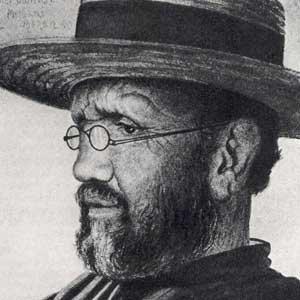 St Jozef Damien De Veuster, ss.cc, was born at Tremelo, Belgium, on 3 January 1840 (see also p. 8). Jozef (“Jef”) began his novitiate with the Congregation of the Sacred Hearts of Jesus and Mary (“Picpus Fathers”) at the beginning of 1859 and took the name Damien. He would pray every day before a picture of St Francis
St Jozef Damien De Veuster, ss.cc, was born at Tremelo, Belgium, on 3 January 1840 (see also p. 8). Jozef (“Jef”) began his novitiate with the Congregation of the Sacred Hearts of Jesus and Mary (“Picpus Fathers”) at the beginning of 1859 and took the name Damien. He would pray every day before a picture of St Francis
Xavier, patron of missionaries, to be sent on a mission. In 1863 his brother, who was to leave for a mission in the Hawaiian Islands, fell ill. Since preparations for the voyage had already been made, Damien obtained permission from the Superior General to take his brother’s place. He landed in Honolulu on 19 March 1864. He was ordained to the priesthood on the following 21 May.
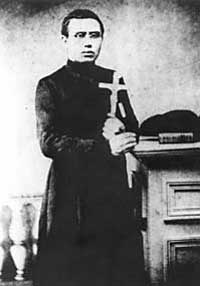 At that time, the Hawaiian Government decided on the harsh measure of quarantine aimed at preventing the spread of leprosy: the deportation to the neighbouring Island of Molokai of all those infected by what was then thought to be an incurable disease. The entire mission was concerned about the abandoned lepers and Bishop Louis Maigret, a Picpus father, felt sure they needed priests. He did not want to send anyone “in the name of obedience” because he was aware such an assignment was a potential death sentence. Of the four brothers who volunteered, Damien was the first to leave on 10 May 1873 for Kalaupapa.
At that time, the Hawaiian Government decided on the harsh measure of quarantine aimed at preventing the spread of leprosy: the deportation to the neighbouring Island of Molokai of all those infected by what was then thought to be an incurable disease. The entire mission was concerned about the abandoned lepers and Bishop Louis Maigret, a Picpus father, felt sure they needed priests. He did not want to send anyone “in the name of obedience” because he was aware such an assignment was a potential death sentence. Of the four brothers who volunteered, Damien was the first to leave on 10 May 1873 for Kalaupapa.
At his own request and that of the lepers, he remained on Molokai. Having contracted leprosy himself, he died on 15 April 1889, at the age of 49, after serving 16 years among the lepers. He was buried in the local cemetery under the same Pandanus tree where he had first slept upon his arrival in Molokai. His remains were exhumed in 1936 at the request of the Belgian Government and translated to a crypt of the Church of the Congregation of the Sacred Hearts at Louvain. Damien is universally known for having freely shared the life of the lepers in quarantine on the Kalaupapa Peninsula of Molokai. His departure for the “cursed isle”, the announcement of his illness (leprosy) in 1884 and his subsequent death deeply impressed his contemporaries of all denominations.
Damien was above all a Catholic missionary. Fr Damien is known today as a hero of charity because he identified so closely with 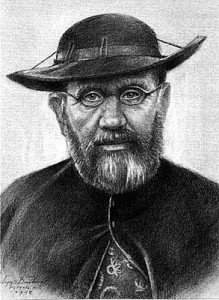 thevictims of leprosy.
thevictims of leprosy.
He respected the religious convictions of others; he accepted them as people and received with joy their collaboration and their help. With a heart wide open to the most abject and wretched, he showed no difference in his approach and in his care of the lepers. In his parish ministry or in his works of charity he found a place for everyone.
He continues to inspire thousands of believers and non-believers who wish to imitate him and to discover the source of his heroism. People of all creeds and all philosophical systems recognized in him the Servant of God which he always revealed himself to be, and respect his passion for the salvation of souls.
Pope John Paul II beatified Damien de Veuster in Brussels on 4 June 1995.
Tags: apostle, damien de veuster, Dr Matthew Bunson, lepers, Margaret Bunson, matthew bunson
This entry was posted on Friday, May 10th, 2013 at 5:37 am
You can follow any responses to this entry through the RSS 2.0 feed.
St. Athanasius is one of the great Father and Doctors of the Church…the Father of Orthodoxy. His extraordinary life is shared with us by Mike Aquilina. When we say “consubstantial” at mass it’s due in part to St. Athansius and the battle against the Arian Heresy. Take a listen and learn more…
[powerpress]
More on the life of St. Athanasius from Pope Benedict at Vatican.va
GENERAL AUDIENCE
Paul VI Audience Hall
Wednesday, 20 June 2007
Continuing our revisitation of the great Teachers of the ancient Church, let us focus our attention today on St Athanasius of Alexandria.
>Only a few years after his death, this authentic protagonist of the Christian tradition was already hailed as “the pillar of the Church” by Gregory of Nazianzus, the great theologian and Bishop of Constantinople (Orationes, 21, 26), and he has always been considered a model of orthodoxy in both East and West.As a result, it was not by chance that Gian Lorenzo Bernini placed his statue among those of the four holy Doctors of the Eastern and Western Churches – together with the images of Ambrose, John Chrysostom and Augustine – which surround the Chair of St Peter in the marvellous apse of the Vatican Basilica.
Athanasius was undoubtedly one of the most important and revered early Church Fathers. But this great Saint was above all the impassioned theologian of the Incarnation of the Logos, the Word of God who – as the Prologue of the fourth Gospel says – “became flesh and dwelt among us” (Jn 1: 14).
For this very reason Athanasius was also the most important and tenacious adversary of the Arian heresy, which at that time threatened faith in Christ, reduced to a creature “halfway” between God and man, according to a recurring tendency in history which we also see manifested today in various forms.
In all likelihood Athanasius was born in Alexandria, Egypt, in about the year 300 A.D. He received a good education before becoming a deacon and secretary to the Bishop of Alexandria, the great Egyptian metropolis. As a close collaborator of his Bishop, the young cleric took part with him in the Council of Nicaea, the first Ecumenical Council, convoked by the Emperor Constantine in May 325 A.D. to ensure Church unity. The Nicene Fathers were thus able to address various issues and primarily the serious problem that had arisen a few years earlier from the preaching of the Alexandrian priest, Arius.
With his theory, Arius threatened authentic faith in Christ, declaring that the Logos was not a true God but a created God, a creature “halfway” between God and man who hence remained for ever inaccessible to us. The Bishops gathered in Nicaea responded by developing and establishing the “Symbol of faith” [“Creed”] which, completed later at the First Council of Constantinople, has endured in the traditions of various Christian denominations and in the liturgy as the Niceno-Constantinopolitan Creed.
In this fundamental text – which expresses the faith of the undivided Church and which we also recite today, every Sunday, in the Eucharistic celebration – the Greek term homooúsiosis featured, in Latin consubstantialis: it means that the Son, the Logos, is “of the same substance” as the Father, he is God of God, he is his substance. Thus, the full divinity of the Son, which was denied by the Arians, was brought into the limelight. (more…)
Tags: Church, faith, saints, St Athanasius
This entry was posted on Thursday, May 2nd, 2013 at 12:26 am
You can follow any responses to this entry through the RSS 2.0 feed.
Episode 22 Beginning to Pray: Â St. Catherine of Siena

[powerpress]
From Dr. Lilles’ “Beginning to Pray” Â blog site:
Catherine of Siena – passion for truth
She is an important figure for those who see a rediscovery of prayer as the force of renewal in the Church. Because she put her devotion to Christ first, she found herself with a spiritual mission to help restore the life and unity of Christ’s body. Some of her efforts met with a little success. But as she approached her death at the age of 33, her lifetime of effort in building up the Church seemed to be in vain. Corruption, scandal, cowardice – and most of all indifference – seemed to infect the Church even more. (For more on her life, go tohttp://www.newadvent.org/cathen/03447a.htm.) Yet she never lost hope and she persevered in prayer. This is because she understood the love and mercy of God.She was uneducated, but in 1377, by a miracle, she learned to write. Even so she retained secretaries to whom she dictated most of her thoughts. Her master work on the spiritual life is known as the Dialogues. These are conversations between her soul and God the Father. God the Father reveals his deep love for his Son and his plan to build up the Church. One of the beautiful aspects of this conversation is the Father’s explanation for how each soul can come to know Jesus.
Christ is the bridge to the Father and we cross this bridge by allowing our hearts to be pierced by what the Lord has done for us. The passion of Christ reveals at once the truth about who God is and who we are in his sight. For her, among the greatest blocks to the spiritual life is ignorance. Knowledge of God and knowledge of self go hand in hand in progressing toward spiritual maturity. But the knowing is not simply an intellectual trip. It as the kind of knowing informed by the loving affection of a real friendship. The friendship she describes in tender terms evokes the deepest joys and sorrows all at once.
The gift of tears, so central to early Dominican spirituality, is a beautiful part of this description. She presents those holy affections as the only proper response to the great love revealed in Christ crucified. These tears move us away from sin and into the very heart of God. She describes this as a journey that begins with kissing the feet of Jesus and entering into his wounded side. For her, intimacy with the Lord is always through the Cross and informed by a profound gratitude and humility.
One other beautiful feature of her spirituality is her understanding of virtue. This understanding is not quite classical in that she goes beyond the generic definition of a virtue as a good habit. Instead, she addresses a problem that is related to life in the Church. She notices that different Christians excel at different virtues. One might have a special aptitude for the art of getting on with others and is a special source of justice in the community. Another may be especially able to enter into the heart of someone enduring great difficulty and brings to the Church a particular awareness of mercy. Still another might have a profound gift of prayer. The question she takes up is why has the Father given different gifts to different members of the Body of Christ.
In the Dialogues, the Father explains to her that He has distributed his bountiful gifts in this way so that each member of the Body of Christ must rely on all the other members and at the same time each member bears a particular responsibility to support the Body of Christ commensurate to the gifts he has been given. In other words, his has distributed his gifts in a manner that disposes us to love one another. And the Father is counting on this mutual love, this genuine fellowship. It is part of His plan that as we cross Christ the Bridge we enter into communion with Him not merely individually, but together as a family.
The family of God requires a new kind of love, a love which only God can give us. A beautiful foundation is laid for what will later be understood as a “call within a call,” that particular mission each one is entrusted with in the eternal loving plan of God. On one hand, answering this call involves some suffering – just as Mother Theresa in our own time discovered. But those who endure this would not have it any other way. There is a certain joy and fullness of life that one discovers when one generously embraces the loving plan of the Father. The possibility of this joyful fulness makes Catherine’s message to the Church dynamically attractive.
For those beginning to pray, Catherine sheds light on the importance of truth, devotion to Christ and the life of the Church. These things organically hang together in her vision of the spiritual life so that growing in prayer goes beyond the merely therapeutic: it opens up the possibility of fully thriving, of living life to the full.
Dr. Anthony Lilles is a Catholic husband and father of three teaching Spiritual Theology at St. John Vianney Theological Seminary. He  teaches spiritual theology and spiritual direction to transitional deacons, and the spiritual classics to the men who enter the Spirituality Year, a year of prayer in preparation for seminary formation.  He is the author of the “Beginning to Pray”  catholic blog spot.
For other episodes in the series visit the Discerning Hearts page for Dr. Anthony Lilles
Tags: Anthony Lilles, Church, prayer, spiritual life, st catherine of siena
This entry was posted on Monday, April 29th, 2013 at 7:26 am
You can follow any responses to this entry through the RSS 2.0 feed.
[powerpress]
O Supreme Physician
O Supreme Physician! O unspeakable Love of my soul! I have recourse to Thee. O infinite and eternal Trinity, I, though unworthy, ardently sigh for Thee! I turn to Thee in the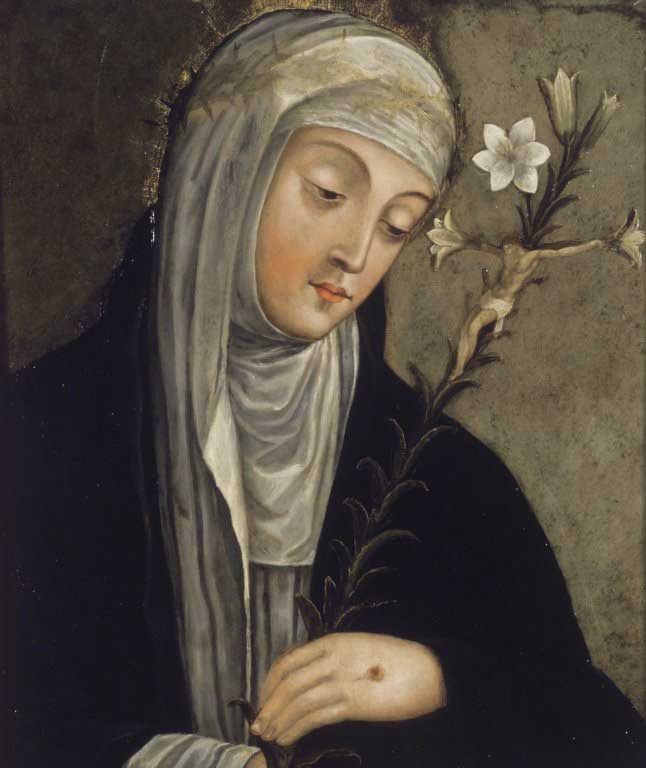 mystical body of Thy holy Church, so that Thou mayest wash away with Thy grace all stains of my soul. I beseech Thee through the merits of St. Peter, to whom Thou hast committed the care of Thy Bark, to delay no longer to help Thy Spouse, who hopes in the fire of Thy charity and in the abyss of Thy admirable wisdom. Despise not the desires of Thy servants, but do Thou Thyself guide Thy holy Bark. O Thou, the Author of peace, draw unto Thyself all the faithful; dispel the darkness of the storm, so that the dawn of Thy light may shine upon the Head of Thy Church, and pour down upon him zeal for the salvation of souls. O eternal and merciful Father, Thou hast given us the means of restraining the arms of Thy justice in the humble prayer and ardent desires of Thy devoted servants, whom Thou hast promised to hear when they ask Thee to have mercy upon the world. O powerful and eternal God, I thank Thee for the peace which Thou wilt grant to Thy Spouse! I will enter into Thy gardens, and there I will remain until I see the fulfilment of Thy promises, which never fail. Wash away our sins, O Lord, and purify our souls in the blood which Thy only-begotten Son shed for us, so that with joyful countenances and pure hearts we may return love for love, and, dying to ourselves, live for Him alone. Amen.
mystical body of Thy holy Church, so that Thou mayest wash away with Thy grace all stains of my soul. I beseech Thee through the merits of St. Peter, to whom Thou hast committed the care of Thy Bark, to delay no longer to help Thy Spouse, who hopes in the fire of Thy charity and in the abyss of Thy admirable wisdom. Despise not the desires of Thy servants, but do Thou Thyself guide Thy holy Bark. O Thou, the Author of peace, draw unto Thyself all the faithful; dispel the darkness of the storm, so that the dawn of Thy light may shine upon the Head of Thy Church, and pour down upon him zeal for the salvation of souls. O eternal and merciful Father, Thou hast given us the means of restraining the arms of Thy justice in the humble prayer and ardent desires of Thy devoted servants, whom Thou hast promised to hear when they ask Thee to have mercy upon the world. O powerful and eternal God, I thank Thee for the peace which Thou wilt grant to Thy Spouse! I will enter into Thy gardens, and there I will remain until I see the fulfilment of Thy promises, which never fail. Wash away our sins, O Lord, and purify our souls in the blood which Thy only-begotten Son shed for us, so that with joyful countenances and pure hearts we may return love for love, and, dying to ourselves, live for Him alone. Amen.
[powerpress url=”http://www.old.discerninghearts.com/Devotionals/St.-Catherine-of-Siena-My-Nature-Is-Fire.mp3″]Download (right click & choose “Save Link As”)
May Nature Is Fire
In your nature, eternal Godhead,
I shall come to know my nature.
And what is my nature, boundless love?
It is fire,
because you are nothing but a fire of love.
And you have given humankind
a share in this nature,
for by the fire of love you created us.
And so with all other people
and every created thing;
you made them out of love.
O ungrateful people!
What nature has your God given you?
His very own nature!
Are you not ashamed to cut yourself off from such a noble thing
through the guilt of deadly sin?
O eternal Trinity, my sweet love!
You, light, give us light.
You, wisdom, give us wisdom.
You, supreme strength, strengthen us.
Today, eternal God,
let our cloud be dissipated
so that we may perfectly know and follow your Truth in truth,
with a free and simple heart.
God, come to our assistance!
Lord, make haste to help us!
Amen.
[powerpress url=”http://www.old.discerninghearts.com/Devotionals/St.-Catherine-of-Siena-Supreme-Ineffable-God.mp3″]Download (right click & choose “Save Link As”)
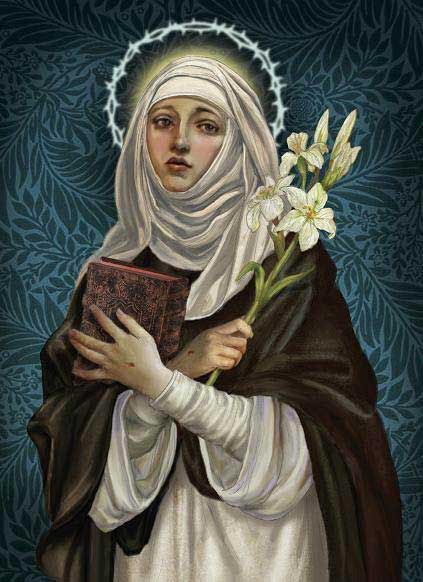 O Supreme and Ineffable God
O Supreme and Ineffable God
O Supreme and Ineffable God, I have sinned! Therefore, I am unworthy to pray to Thee. But Thou canst make me less unworthy. Punish my sins, O Lord, but turn not away from my misery. From Thee I have received a body which I offer to Thee. Behold my body and my blood! Strike, destroy, reduce my bones to dust, but grant me what I ask for the Sovereign Pontiff, the one Bridegroom of Thy Spouse. May he always know Thy will, may he love it and follow it, so that we may not perish. O my God, create a new heart in him! May he ever receive an increase of Thy grace; may he never tire of bearing the standard of Thy holy cross; and may he bestow the treasures of Thy mercy upon unbelievers as he bestows them upon us who enjoy the benefits of the passion and blood of Thy most beloved Son, the Lamb without a spot. O Lord, eternal God, have mercy on me for I have sinned.
For the Novena to St. Catherine of Siena page
Tags: eternal God, eternal Trinity, O Supreme Physician, st catherine of siena
This entry was posted on Monday, April 29th, 2013 at 5:51 am
You can follow any responses to this entry through the RSS 2.0 feed.
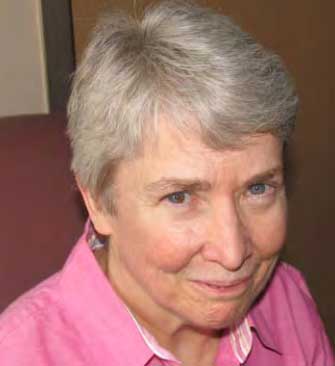 It was a delight to once again talk with Sr. Janice McGrane S. S. J., this time about her book “Saints for Healing:  Stories of Courage and Hope”.  In this, her second book, she  offers a short biography of the lives of 11 saints,  their background on relevant cultural issues, and a reflection.  Each saint has a special connection to “healing”…some are expected, some are a wonderful surprise.  Sr. Janice has introduced us to special companions who can walk with us on the journey to our ultimate destination….an encounter with the Divine Physician.  Marvelous, simply marvelous.
It was a delight to once again talk with Sr. Janice McGrane S. S. J., this time about her book “Saints for Healing:  Stories of Courage and Hope”.  In this, her second book, she  offers a short biography of the lives of 11 saints,  their background on relevant cultural issues, and a reflection.  Each saint has a special connection to “healing”…some are expected, some are a wonderful surprise.  Sr. Janice has introduced us to special companions who can walk with us on the journey to our ultimate destination….an encounter with the Divine Physician.  Marvelous, simply marvelous.
[powerpress]
 For a copy of the book
For a copy of the book
From the book description:
With grace and insight, McGrane tells us also about healing that occurs on a larger scale: Joan of Arc healed the morale of France in its most dire hour, Edith Stein and Maximilian Kolbe offered comfort and consolation in the midst of the horror of Auschwitz, Henriette DeLille transceneded the racism of her time to minister with slaves, Hildegard of Bingen shared her knowledge of herbs to heal others, Catherine of Siena helped repair a divided and corrupt church, Damien ministered to the lepers of Molokai. These stories and those about Teresa of Avila, Dorothy Day, Mother Teresa, Archbishop Romero, and Fr. Mychal Judge lead us to these healing saints for compaionship and inspiration when we, too, hurt.
This entry was posted on Wednesday, April 10th, 2013 at 2:50 pm
You can follow any responses to this entry through the RSS 2.0 feed.
Mike Aquilina offers us deep insight on the life of St. Cyril of Jerusalem.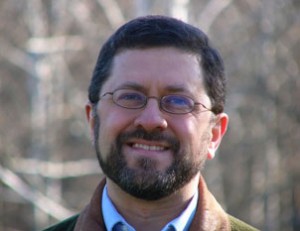
[powerpress]
More on St. Cyril of Jerusalem from vatican.va:
BENEDICT XVI’s GENERAL AUDIENCE
Paul VI Audience Hall
Wednesday, 27 June 2007
Dear Brothers and Sisters,
Our attention today is focused on St Cyril of Jerusalem. His life is woven of two dimensions: on the one hand, pastoral care, and on the other, his involvement, in spite of himself, in the heated controversies that were then tormenting the Church of the East.
Cyril was born at or near Jerusalem in 315 A.D. He received an excellent literary education which formed the basis of his ecclesiastical culture, centred on study of the Bible. He was ordained a priest by Bishop Maximus.
When this Bishop died or was deposed in 348, Cyril was ordained a Bishop by Acacius, the influential Metropolitan of Caesarea in Palestine, a philo-Arian who must have been under the impression that in Cyril he had an ally; so as a result Cyril was suspected of having obtained his episcopal appointment by making concessions to Arianism.
Actually, Cyril very soon came into conflict with Acacius, not only in the field of doctrine but also in that of jurisdiction, because he claimed his own See to be autonomous from the Metropolitan See of Caesarea.
Cyril was exiled three times within the course of approximately 20 years: the first time was in 357, after being deposed by a Synod of Jerusalem; followed by a second exile in 360, instigated by Acacius; and finally, in 367, by a third exile – his longest, which lasted 11 years – by the philo-Arian Emperor Valens.
It was only in 378, after the Emperor’s death, that Cyril could definitively resume possession of his See and restore unity and peace to his faithful.
Some sources of that time cast doubt on his orthodoxy, whereas other equally ancient sources come out strongly in his favour. The most authoritative of them is the Synodal Letter of 382 that followed the Second Ecumenical Council of Constantinople (381), in which Cyril had played an important part.
In this Letter addressed to the Roman Pontiff, the Eastern Bishops officially recognized Cyril’s flawless orthodoxy, the legitimacy of his episcopal ordination and the merits of his pastoral service, which ended with his death in 387.
Of Cyril’s writings, 24 famous catecheses have been preserved, which he delivered as Bishop in about 350.
Introduced by a Procatechesis of welcome, the first 18 of these are addressed to catechumens or candidates for illumination (photizomenoi) [candidates for Baptism]; they were delivered in the Basilica of the Holy Sepulchre. Each of the first ones (nn. 1-5) respectively treat the prerequisites for Baptism, conversion from pagan morals, the Sacrament of Baptism, the 10 dogmatic truths contained in the Creed or Symbol of the faith.
The next catecheses (nn. 6-18) form an “ongoing catechesis” on the Jerusalem Creed in anti-Arian tones.
Of the last five so-called “mystagogical catecheses”, the first two develop a commentary on the rites of Baptism and the last three focus on the Chrism, the Body and Blood of Christ and the Eucharistic Liturgy. They include an explanation of the Our Father (Oratio dominica).
This forms the basis of a process of initiation to prayer which develops on a par with the initiation to the three Sacraments of Baptism, Confirmation and the Eucharist.
The basis of his instruction on the Christian faith also served to play a polemic role against pagans, Judaeo Christians and Manicheans. The argument was based on the fulfilment of the Old Testament promises, in a language rich in imagery.
Catechesis marked an important moment in the broader context of the whole life – particularly liturgical – of the Christian community, in whose maternal womb the gestation of the future faithful took place, accompanied by prayer and the witness of the brethren.
Taken as a whole, Cyril’s homilies form a systematic catechesis on the Christian’s rebirth through Baptism.
He tells the catechumen: “You have been caught in the nets of the Church (cf. Mt 13: 47). Be taken alive, therefore; do not escape for it is Jesus who is fishing for you, not in order to kill you but to resurrect you after death. Indeed, you must die and rise again (cf. Rom 6: 11, 14)…. Die to your sins and live to righteousness from this very day” (Procatechesis, 5).
From the doctrinal viewpoint, Cyril commented on the Jerusalem Creed with recourse to the typology of the Scriptures in a “symphonic” relationship between the two Testaments, arriving at Christ, the centre of the universe.
The typology was to be described decisively by Augustine of Hippo: “In the Old Testament there is a veiling of the New, and in the New Testament there is a revealing of the Old” (De catechizandis rudibus 4, 8).
As for the moral catechesis, it is anchored in deep unity to the doctrinal catechesis: the dogma progressively descends in souls who are thus urged to transform their pagan behaviour on the basis of new life in Christ, a gift of Baptism.
The “mystagogical” catechesis, lastly, marked the summit of the instruction that Cyril imparted, no longer to catechumens but to the newly baptized or neophytes during Easter week. He led them to discover the mysteries still hidden in the baptismal rites of the Easter Vigil.
Enlightened by the light of a deeper faith by virtue of Baptism, the neophytes were at last able to understand these mysteries better, having celebrated their rites.
Especially with neophytes of Greek origin, Cyril made use of the faculty of sight which they found congenial. It was the passage from the rite to the mystery that made the most of the psychological effect of amazement, as well as the experience of Easter night.
Here is a text that explains the mystery of Baptism: “You descended three times into the water, and ascended again, suggesting by a symbol the three days burial of Christ, imitating Our Saviour who spent three days and three nights in the heart of the earth (cf. Mt 12: 40). Celebrating the first emersion in water you recall the first day passed by Christ in the sepulchre; with the first immersion you confessed the first night passed in the sepulchre: for as he who is in the night no longer sees, but he who is in the day remains in the light, so in the descent, as in the night, you saw nothing, but in ascending again you were as in the day. And at the self-same moment you were both dying and being born; and that water of salvation was at once your grave and your mother…. For you… the time to die goes hand in hand with the time to be born: one and the same time effected both of these events” (cf. Second Mystagogical Catechesis, n. 4).
The mystery to be understood is God’s plan, which is brought about through Christ’s saving actions in the Church.
In turn, the mystagogical dimension is accompanied by the dimension of symbols which express the spiritual experience they “explode”. Thus, Cyril’s catechesis, on the basis of the three elements described – doctrinal, moral and lastly, mystagogical – proves to be a global catechesis in the Spirit.
The mystagogical dimension brings about the synthesis of the two former dimensions, orienting them to the sacramental celebration in which the salvation of the whole human person takes place.
In short, this is an integral catechesis which, involving body, soul and spirit – remains emblematic for the catechetical formation of Christians today.
Tags: Church, doctor of the church, faith, father of the church, mike aquilina, mysteries, st cyril of jerusalem
This entry was posted on Monday, March 18th, 2013 at 12:04 am
You can follow any responses to this entry through the RSS 2.0 feed.
From the official Lourdes website (visit it …. it’s fantastic!)
On 11th. February 1858 Bernadette, her sister Toinette and a friend of theirs, Jeanne, went looking for wood on the meadows and led towards “the place where the canal rejoins the River Gave”. They were in front of the Grotto of Massabielle. Toinette and Jeanne crossed the icy water, crying out with the cold; Bernadette hesitated to do this because of her chronic asthma. She heard “a noise like a gust of wind”, but “none of the trees were moving”. “Raising her head, she saw, in a hollow of the rock a small young lady, who looked at her and who smiled at her. This was the first Apparition of the Virgin Mary
More from the official site
On 25th. March 1858, the day of the sixteenth Apparition, Bernadette went to the Grotto, and on the instigation of the Parish Priest, Abbé‚ Peyramale, asked the Lady for her name. Three times Bernadette asked the question. On the fourth request, the Lady responds in dialect “Que soy era Immaculada Conception“. (“I am the Immaculate Conception”). Bernadette does not understand immediately the meaning of these words. The Immaculate Conception is, as the Church teaches, “Mary, conceived without sin, thanks to the merits of the Cross of Christ”. (The definition of the Dogma of the Immaculate Conception 1854) She goes to the Parish Priest to tell him the Lady’s name. He understands that it is the Mother of God who has appeared at the Grotto of Massabielle. Later the Bishop of Tarbes, Monseigneur Laurence, confirms this.
The Immaculate Conception is, as the Church teaches, “Mary, conceived without sin, thanks to the merits of the Cross of Christ”. Thus the Immaculate Conception is also the sign of what all people, recreated by God are called to be.
A prayer to Our Lady of Lourdes by Pope John Paul II
[powerpress=”devotionals-prayers”]
Hail Mary, poor and humble Woman,
Blessed by the Most High!
Virgin of hope, dawn of a new era,
We join in your song of praise,
to celebrate the Lord’s mercy,
to proclaim the coming of the Kingdom
and the full liberation of humanity.
Hail Mary, lowly handmaid of the Lord,
Glorious Mother of Christ!
Faithful Virgin, holy dwelling-place of the Word,
Teach us to persevere in listening to the Word,
and to be docile to the voice of the Spirit,
attentive to his promptings in the depths of our conscience
and to his manifestations in the events of history.
Hail Mary, Woman of sorrows,
Mother of the living!
Virgin spouse beneath the Cross, the new Eve,
Be our guide along the paths of the world.
Teach us to experience and to spread the love of Christ,
to stand with you before the innumerable crosses
on which your Son is still crucified.
Hail Mary, woman of faith,
First of the disciples!
Virgin Mother of the Church, help us always
to account for the hope that is in us,
with trust in human goodness and the Father’s love.
Teach us to build up the world beginning from within:
in the depths of silence and prayer,
in the joy of fraternal love,
in the unique fruitfulness of the Cross.
Holy Mary, Mother of believers,
Our Lady of Lourdes,
pray for us.
Amen.
Tags: Church, dogma of the immaculate conception, immaculate conception, our lady of lourdes, Parish Priest, sin, st. bernadette
This entry was posted on Monday, February 11th, 2013 at 12:14 am
You can follow any responses to this entry through the RSS 2.0 feed.
Join us with Teresa Monaghen, of Pro Sanctity,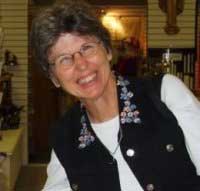 as we discuss the life of St. Scholastica
as we discuss the life of St. Scholastica
[powerpress]
From Gregory the Great (c. 540-604), Dialogues, Book II (Life and Miracles of St. Benedict). Courtesy of the Saint Pachomius Library.
CHAPTER THIRTY-THREE: Of a Miracle Wrought by his Sister, Scholastica.
GREGORY: Who is there, Peter, in this world, that is in greater favor with God than St. Paul? Three times he petitioned our Lord
to be delivered from the thorn of the flesh, and yet he did not obtain his petition. Speaking of that, I must tell you how there was one thing which the venerable father Benedict would have liked to do, but he could not.
His sister, named Scholastica, was dedicated from her infancy to our Lord. Once a year she came to visit her brother. The man of God went to her not far from the gate of his monastery, at a place that belonged to the Abbey. It was there he would entertain her. Once upon a time she came to visit according to her custom, and her venerable brother with his monks went there to meet her.
They spent the whole day in the praises of God and spiritual talk, and when it was almost night, they dined together. As they were yet sitting at the table, talking of devout matters, it began to get dark. The holy Nun, his sister, entreated him to stay there all night that they might spend it in discoursing of the joys of heaven. By no persuasion, however, would he agree to that, saying that he might not by any means stay all night outside of his Abbey.
At that time, the sky was so clear that no cloud was to be seen. The
Nun, hearing this denial of her brother, joined her hands together, laid them on the table, bowed her head on her hands, and prayed to almighty God.
Lifting her head from the table, there fell suddenly such a tempest of lightning and thundering, and such abundance of rain, that neither venerable Benedict, nor his monks that were with him, could put their heads out of doors. The holy Nun, having rested her head on her hands, poured forth such a flood of tears on the table, that she transformed the clear air to a watery sky.
After the end of her devotions, that storm of rain followed; her prayer and the rain so met together, that as she lifted up her head from the table, the thunder began. So it was that in one and the very same instant that she lifted up her head, she brought down the rain.
The man of God, seeing that he could not, in the midst of such thunder and lightning and great abundance of rain return to his Abbey, began to be heavy and to complain to his sister, saying: “God forgive you, what have you done?” She answered him, “I desired you to stay, and you would not hear me; I have desired it of our good Lord, and he has granted my petition. Therefore if you can now depart, in God’s name return to your monastery, and leave me here alone.”
Departure Delayed
But the good father, not being able to leave, tarried there against his will where before he would not have stayed willingly. By that means, they watched all night and with spiritual and heavenly talk
mutually comforted one another.
Therefore, by this we see, as I said before, that he would have had one thing, but he could not effect it. For if we know the venerable man’s mind, there is no question but that he would have had the same fair weather to have continued as it was when he left his monastery. He found, however, that a miracle prevented his desire. A miracle that, by the power of almighty God, a woman’s prayers had wrought.
Is it not a thing to be marveled at, that a woman, who for a long time had not seen her brother, might do more in that instance than he could? She realized, according to the saying of St. John, “God is charity” [1 John 4:8]. Therefore, as is right, she who loved more, did more.
PETER: I confess that I am wonderfully pleased with that which you tell me.
CHAPTER THIRTY-FOUR: How Benedict Saw the Soul of his Sister Ascend into Heavenly Glory.
GREGORY: The next day the venerable woman returned to her nunnery, and the man of God to his abbey. Three days later, standing in his cell, and lifting up his eyes to heaven, he beheld the soul of his sister (which was departed from her body) ascend into heaven in the likeness of a dove.
Rejoicing much to see her great glory, with hymns and praise he gave thanks to almighty God, and imparted the news of her death to his monks. He sent them presently to bring her corpse to his Abbey, to have it buried in that grave which he had provided for himself. By this means it fell out that, as their souls were always one in God while they lived, so their bodies continued together after their death.
— Collect
Prayer: O God, to show us where innocence leads, you made the soul of your virgin Saint Scholastica soar to heaven like a dove in flight. Grant through her merits and her prayers that we may so live in innocence as to attain to joys everlasting. This we ask through our Lord.
Tags: heaven, prayers, Saint Scholastica, teresa monaghen
This entry was posted on Sunday, February 10th, 2013 at 12:50 pm
You can follow any responses to this entry through the RSS 2.0 feed.
One of my very favorite storytellers is Sr. Joan Mueller…give yourself the gift of hearing her share the story of St. 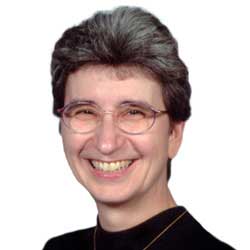 Bakhita in this podcast…
Bakhita in this podcast…
JOSEPHINE BAKHITA (1869-1947)
Mother Josephine Bakhita was born in Sudan in 1869 and died in Schio (Vicenza)Â in 1947.
This African flower, who knew the anguish of kidnapping and slavery, bloomed marvelously in Italy, in response to God’s grace, with the Daughters of Charity.
Mother “Morettaâ€
In Schio (Vicenza), where she spent many years of her life, everyone still calls her “our Black Motherâ€. The process for the cause of Canonization began 12 years after her death and on December 1st, 1978 the Church proclaimed the Decree of the heroic practice of all virtues.
Divine Providence which “cares for the flowers of the fields and the birds of the airâ€, guided the Sudanese slave through innumerable and unspeakable sufferings to human freedom and to the freedom of faith and finally to the consecration of her whole life to God for the coming of his Kingdom.In Slavery
Bakhita was not the name she received from her parents at birth. The fright and the terrible experiences she went through made her forget the name she was given by her parents. Bakhita, which means “fortunateâ€, was the name given to her by her kidnappers.
Sold and resold in the markets of El Obeid and of Khartoum, she experienced the humiliations and sufferings of slavery, both physical and moral.Towards freedom
In the Capital of Sudan, Bakhita was bought by an Italian Consul, Callisto Legnani . For the first time since the day she was kidnappe
d, she realized with pleasant surprise, that no one used the lash when giving her orders; instead, she was treated in a loving and cordial way. In the Consul’s residence, Bakhita experienced peace, warmth and moments of joy, even though veiled by nostalgia for her own family, whom, perhaps, she had lost forever.
Political situations forced the Consul to leave for Italy. Bakhita asked and obtained permission to go with him and with a friend of his, a certain Mr. Augusto Michieli.In Italy
On arrival in Genoa, Mr. Legnani, pressured by the request of Mr. Michieli’s wife, consented to leave Bakhita with them. She followed the new “familyâ€, which settled in Zianigo (near Mirano Veneto). When their daughter Mimmina was born, Bakhita became her babysitter and friend.
The acquisition and management of a big hotel in Suakin, on the Red Sea, forced Mrs. Michieli to move to Suakin to help her husband. Meanwhile, on the advice of their administrator, Illuminato Checchini, Mimmina and Bakhita were entrusted to the Canossian Sisters of the Institute of the Catechumens in Venice. It was there that Bakhita came to know about God whom “she had experienced in her heart without knowing who He was†ever since she was a child. “Seeing the sun, the moon and the stars, I said to myself: Who could be the Master of these beautiful things? And I felt a great desire to see him, to know Him and to pay Him homage…â€Daughter of God
After several months in the catechumenate, Bakhita received the sacraments of Christian initiation and was given the new name, Josephine. It was January 9, 1890. She did not know how to express her joy that day. Her big and expressive eyes sparkled, revealing deep emotions. From then on, she was often seen kissing the baptismal font and saying: “Here, I became a daughter of God!â€
With each new day, she became more aware of who this God was, whom she now knew and loved, who had led her to Him through mysterious ways, holding her by the hand.When Mrs. Michieli returned from Africa to take back her daughter and Bakhita, the latter, with unusual firmness and courage, expressed her desire to remain with the Canossian Sisters and to serve that God who had shown her so many proofs of His love.
The young African, who by then had come of age, enjoyed the freedom of choice which the Italian law ensured.Bakhita remained in the catechumenate where she experienced the call to be a religious, and to give herself to the Lord in the Institute of St. Magdalene of Canossa.
On December 8, 1896 Josephine Bakhita was consecrated forever to God whom she called with the sweet expression “the Master!â€
For another 50 years, this humble Daughter of Charity, a true witness of the love of God, lived in the community in Schio, engaged in various services: cooking, sewing, embroidery and attending to the door.
When she was on duty at the door, she would gently lay her hands on the heads of the children who daily attended the Canossian schools and caress them. Her amiable voice, which had the inflection and rhythm of the music of her country, was pleasing to the little ones, comforting to the poor and suffering and encouraging for those who knocked at the door of the Institute.Witness of love
Her humility, her simplicity and her constant smile won the hearts of all the citizens. Her sisters in the community esteemed her for her inalterable sweet nature, her exquisite goodness and her deep desire to make the Lord known.
“Be good, love the Lord, pray for those who do not know Him. What a great grace it is to know God!â€As she grew older she experienced long, painful years of sickness.
Mother Bakhita continued to witness to faith, goodness and Christian hope. To those who visited her and asked how she was, she would respond with a smile: “As the Master desires.â€Final test
During her agony, she re-lived the terrible days of her slavery and more then once she begged the nurse who assisted her: “Please, loosen the chains… they are heavy!â€
It was Mary Most Holy who freed her from all pain. Her last words were: “Our Lady! Our Lady!â€, and her final smile testifiedto her encounter with the Mother of the Lord.
Mother Bakhita breathed her last on February 8, 1947 at the Canossian Convent, Schio, surrounded by the Sisters. A crowd quickly gathered at the Convent to have a last look at their «Mother Moretta» and to ask for her protection from heaven. The fame of her sanctity has spread to all the continents and many are those who receive graces through her intercession.
Every line of the Collect for Saint Bakhita merits attention; every phrase needs to be repeated in meditation.
O God, who led Saint Josephine Bakhita
from abject slavery
to the dignity of being your daughter and the bride of Christ,
give us, we beseech you, by her example,
to follow after Jesus the Crucified Lord with unremitting love
and, in charity, to persevere in a ready mercy.
Tags: daughters of charity, Jesus, joan mueller, josephine bakhita, love, Mother Bakhita, sr. joan mueller, st. bahkita, st. josephine
This entry was posted on Friday, February 8th, 2013 at 7:21 am
You can follow any responses to this entry through the RSS 2.0 feed.
On Holy Mother Mary
On Holy Repentance
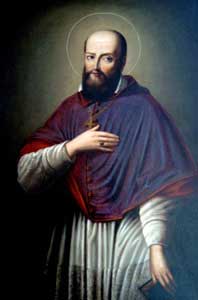 CHAPTER III. Devotion is suitable to every Vocation and Profession.
CHAPTER III. Devotion is suitable to every Vocation and Profession.
WHEN God created the world He commanded each tree to bear fruit after its kind; 88 Gen. i. 12. and even so He bids Christians,—the living trees of His Church,—to bring forth fruits of devotion, each one according to his kind and vocation.
A different exercise of devotion is required of each—the noble, the artisan, the 9 servant, the prince, the maiden and the wife; and furthermore such practice must be modified according to the strength, the calling, and the duties of each individual.
I ask you, my child, would it be fitting that a Bishop should seek to lead the solitary life of a Carthusian? And if the father of a family were as regardless in making provision for the future as a Capucin, if the artisan spent the day in church like a Religious, if the Religious involved himself in all manner of business on his neighbour’s behalf as a Bishop is called upon to do, would not such a devotion be ridiculous, ill-regulated, and intolerable? Nevertheless such a mistake is often made, and the world, which cannot or will not discriminate between real devotion and the indiscretion of those who fancy themselves devout, grumbles and finds fault with devotion, which is really nowise concerned in these errors.
No indeed, my child, the devotion which is true hinders nothing, but on the contrary it perfects everything; and that which runs counter to the rightful vocation of any one is, you may be sure, a spurious devotion.
Aristotle says that the bee sucks honey from flowers without damaging them, leaving them as whole and fresh as it found them;—but true devotion does better still, for it not only hinders no manner of vocation or duty, but, contrariwise, it adorns and beautifies all.
Throw precious 10 stones into honey, and each will grow more brilliant according to its several colour:—and in like manner everybody fulfils his special calling better when subject to the influence of devotion:—family duties are lighter, married love truer, service to our King more faithful, every kind of occupation more acceptable and better performed where that is the guide.
It is an error, nay more, a very heresy, to seek to banish the devout life from the soldier’s guardroom, the mechanic’s workshop, the prince’s court, or the domestic hearth. Of course a purely contemplative devotion, such as is specially proper to the religious and monastic life, cannot be practised in these outer vocations, but there are various other kinds of devotion well-suited to lead those whose calling is secular, along the paths of perfection. The Old Testament furnishes us examples in Abraham, Isaac and Jacob, David, Job, Tobias, Sarah, Rebecca and Judith; and in the New Testament we read of St. Joseph, Lydia and Crispus, who led a perfectly devout life in their trades:—we have S. Anne, Martha, S. Monica, Aquila and Priscilla, as examples of household devotion, Cornelius, S. Sebastian, and S. Maurice among soldiers;—Constantine, S. Helena, S. Louis, the Blessed Amadaeus, 99 It is probable that S. Francis here means to indicate Amadeo IX., Duke of Savoy, who died 1472. and 11 S. Edward on the throne. And we even find instances of some who fell away in solitude,—usually so helpful to perfection,—some who had led a higher life in the world, which seems so antagonistic to it. S. Gregory dwells on how Lot, who had kept himself pure in the city, fell in his mountain solitude. Be sure that wheresoever our lot is cast we may and must aim at the perfect life.
Check out other Discerning Hearts Posts on St. Francis de Sales
[p2p type=”id” value=”2281″]
[p2p type=”id” value=”2622″]
Meditations from the Introduction to the Devout Life by St. Francis de Sales
Tags: chapter xix, devotion, family, heresy, holy mother mary, introduction to the devout life, love, repentance, st francis de sales
This entry was posted on Thursday, January 24th, 2013 at 12:07 am
You can follow any responses to this entry through the RSS 2.0 feed.
Mike Aquilina shares with us the story of St. Agnes.
[powerpress]
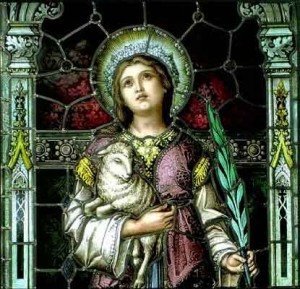 A young girl who would help to break open the hearts of many, so that grace could pour in. She was “a lamb for Christ”.  Mike also discusses the challenges to life, including the “ancient” practice of abortion.
A young girl who would help to break open the hearts of many, so that grace could pour in. She was “a lamb for Christ”.  Mike also discusses the challenges to life, including the “ancient” practice of abortion.
wiki – According to tradition, Saint Agnes was a member of the Roman nobility born c. 291 and raised in a Christian family. She suffered martyrdom at the age of twelveor thirteen during the reign of the Roman Emperor Diocletian, on 21 January 304.
The Prefect Sempronius wished Agnes to marry his son, and on Agnes’ refusal he condemned her to death. As Roman law did not permit the execution of virgins, Sempronius had a naked Agnes dragged through the streets to a brothel. Various versions of the legend give different methods of escape from this predicament. In one, as she prayed, her hair grew and covered her body. It was also said that all of the men who attempted to rape her were immediately struck blind. In another the son of the prefect is struck dead, but revived after Agnes prayed for him, causing her release. There is then a trial from which Sempronius excuses himself, and another figure presides, sentencing her to death. When led out to die she was tied to a stake, but the bundle of wood would not burn, or the flames parted away from her, whereupon the officer in charge of the troops drew his swordbeheaded her, or, in some other texts, stabbed her in the throat. It is also said that the blood of Agnes poured to the stadium floor where other Christians soaked up the blood with cloths. and
The daughter of Constantine I, Saint Constance, was also said to have been cured of leprosy after praying at Agnes’ tomb.
A prayer to St. Agnes
Let us gain courage for our own battle
by honoring the martyrdom of the glorious virgin Agnes.
St. Agnes, vessel of honor,
flower of unfading fragrance,beloved of the choirs of Angels,you are an example to the worth of virtue and chastity.
O you who wear a Martyr’s palm
and a virgin’s wreath,
pray for us that,
though unworthy of a special crown,
we may have our names written in the list of Saints.
Tags: catacomb, fathers mike, hearts, martyrdom, mike aquilina, saint agnes, virgins, virtue
This entry was posted on Monday, January 21st, 2013 at 12:43 am
You can follow any responses to this entry through the RSS 2.0 feed.
(The following wonderful reflection on the life of St. Elzabeth Ann Seton is from Fr. Mark Kirby which can be found on his website  Vultus Christi ….I highly encourage you to check it out!!!
which can be found on his website  Vultus Christi ….I highly encourage you to check it out!!!
Dom Mark Daniel Kirby is Prior of the Diocesan Benedictine Monastery of Our Lady of the Cenacle in Tulsa, Oklahoma.His Excellency Bishop Edward J. Slattery of the Roman Catholic Diocese of Tulsa established the monastery in 2009 with the distinctive mission of Eucharistic Adoration for the sanctification of priests.)
William Magee Seton gave this lithograph of Christ the Redeemer to his beloved wife, Elizabeth Ann Seton, sometime between 1774 and 1803. Its Eucharistic theme prophetically reflected the profound devotion to the Most Holy Eucharist that would characterize her piety as a Catholic.
Below is a photograph of a copy of a variant of the Memorare handwritten by Elizabeth Ann Seton. At the end of text she added the touching plea, “Love me, my Mother.
The Italian Experience
The conversion of Elizabeth Ann Bayley Seton began in 1803 while she, a twenty-nine year old widow with one of her five children, were the guests of the Filicchi family in Livorno, or Leghorn, Italy. The Catholic Filicchis, Antonio and his wife Amabilia, offered her a gracious hospitality and unfailing emotional support in a time of crisis.
The Motherhood of the Blessed Virgin
In one of Signora Filicchi’s prayer books, Mrs. Seton came upon the text of Saint Bernard’s Memorare; she found in the Virgin Mary the tenderness and the pity of a mother. “That night,” she writes, “I cried myself to sleep in her heart.”
The Tabernacle
The Filicchi home contained a private chapel where the Blessed Sacrament was reserved. Elizabeth was drawn to the tabernacle. Even before her mind had been instructed in the mysteries of the Catholic faith, her heart recognized the living presence of the Lord in the Most Holy Eucharist. Her American Protestant sensibility was perplexed and, yet, she could not deny her heart’s fascination with the Lamb of God hidden beneath the sacramental veils.
Return to New York
Elizabeth’s long personal memoir, The Italian Journal, recounts the intimate details of her inner struggle and conversion to Catholicism. Elizabeth and her ten year old daughter, Anna Maria, returned to New York on June 3, 1804, accompanied by Antonio Filicchi — a man to whom Elizabeth had become deeply attached. He had become for her a friend and a spiritual counselor. (more…)
Tags: American Catholics, daughters of charity, elizabeth ann seton, fr. mark daniel kirby, Real Presence, spiritual journey
This entry was posted on Friday, January 4th, 2013 at 12:21 am
You can follow any responses to this entry through the RSS 2.0 feed.

